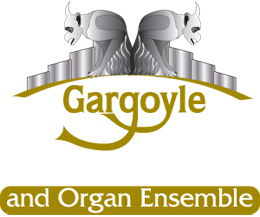No doubt great composers of all times would have scored their best music for brass and organ ensemble, had such an august group been known to them. The Chicago Gargoyle Brass and Organ Ensemble works with some of today’s finest arrangers to transcribe those popular pieces into arrangements that delight audiences of all ages and backgrounds.
Craig Garner (b. 1959) has published more than 100 works during his 35-year career as a musical arranger. His specialty is arranging long-form symphonic works by composers not typically found in the brass quintet repertoire. His close relationship with the Chicago Gargoyle Brass and Organ Ensemble has led to musical collaborations on more than 10 large-scale works for the group. In describing his arranging style for brass and organ ensemble, Mr. Garner has said he hopes for his arrangements “to sound as if they were the original intent of the composer.”http://www.dorm40music.com/
Charles-Camille Saint-Saëns, arr. Craig Garner, dorm40music.com,
“Adagio and Maestoso from Symphony #3”
Adagio movement and an expanded Maestoso with piano arrangement were commissioned by Rodney Holmes for the Gargoyle Brass and Organ Ensemble in 2012.
Without a doubt, the most frequently performed and recorded symphony for organ and orchestra is the Symphony No. 3 by Camille Saint-Saëns (1835-1921). Noted for its melodies, cheerful treatment of the Dies Irae theme, and thundering descending C major scale in the final pedal cadence, it is something of an irony that the organ itself (along with the ornamental four hand piano) plays secondary roles to the orchestra in much of the full symphony. Some listeners have been disappointed when the organ and orchestra have been recorded separately. Disappointing also is when the final organ pedal scale fit for the powerful French Cavaillé-Coll organs is rendered virtually inaudible on some modern playback systems. Craig Garner displays the splendid colors of the concert organ and brass in the Adagio, and gives a prominent role to the organ throughout his arrangement. This performance was recorded and engineered tutti, and the magnificent French-Canadian Casavant organ was registered so as to ensure that the famous organ passages of the Maestoso cannot be missed. http://www.dorm40music.com/
Félix-Alexandre Guilmant, arr. Craig Garner, dorm40music.com,
“Symphony #1”
Gustav Mahler, arr. Craig Garner, dorm40music.com,
“Urlicht and Finale from Symphony #2”
Giuseppe Fortunino Francesco Verdi, arr. Craig Garner, dorm40music.com, “Brindisi, Libiamo from La Traviata”
Commissioned by as an encore for the Chicago Gargoyle Brass and Organ Ensemble
“Libiamo ne’lieti calici” is an Italian brindisi, a toasting or drinking song often featured in nineteenth-century Italian operas. There is perhaps no greater example of such a celebratory brindisi than this one, from the first act of Giuseppe Verdi’s (1813-1901) La Traviata. http://www.dorm40music.com/
Jaromír Weinberger “Polka and Fugue from Schwanda the Bagpiper”
Commissioned by Rodney Holmes and the Chicago Gargoyle Brass, and dedicated to the memory and legacy of O.T. Ryan.
Czech born Jaromír Weinberger (1896-1967), a popular Jewish composer whose sister died in a concentration camp, fled Europe to America for a teaching post at the Ithaca Conservatory. His popularity waned over time, and he died of an overdose of sleeping pills while suffering in seclusion from cancer and depression.
Weinberger’s two act opera based on a Czech folk tale translated as “Schwanda the Bagpiper” is anything but depressing. In the convoluted logic of grand opera comedy, it seems that the peasant farmer and famous bagpiper Schwanda came to be married. The thief Babinski convinces Schwanda that it would be a good idea to celebrate his marriage by playing his bagpipe for the mysterious and melancholy queen (Polka), proposing to her, and kissing her. Trying to explain himself to his wife and swearing an oath of his fidelity, hell’s gateways open landing Schwanda immediately and unceremoniously in hell, where the Devil…a notorious cheater at cards… dances upon that famous bagpipe and claims his soul. The wife displeased by this turn of events drives Babinski to save her husband, which he does by wagering the Devil and winning at a game of cards. In the ensuing distraction and frenzy, Schwanda escapes from hell (Fugue) with his bagpipe wailing each time it strikes a wall (horn).
Polka and Fugue is the popular excerpt still heard in orchestra concert halls, summer bands in the park, and demonstration records of an organ’s place in the orchestra. It was also the choice of O.T. Ryan to take to contest with his Plainview High School band in 1971. Sadly my beloved band director passed away the very weekend I returned to tell him of this Gargoyle commission. This dedication is a tribute to Texas Bandmaster O.T. Ryan (he always insisted that we call him O.T.), and to the inestimable good done by all music educators in the lives of young people everywhere. [Notes by Rodney Holmes]
